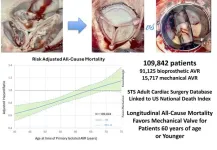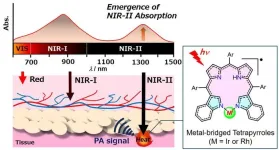(Press-News.org) Understanding the science behind meaty tastes and textures could be the key for more people switch to a planet-friendly plant diet, researchers suggest.
Ole G. Mouritsen, a professor of gastrophysics, addresses the urgent need to make changes to culinary cultures where animal-based proteins play a central role.
Replicating a little-known meaty flavour and a sensation of richness could encourage more plant-based eating, he explains.
“To ensure that there is enough food for a growing world population, to lessen the burden on the environment, and to promote healthier, sustainable eating patterns, it is crucial to transition to a diet that focuses primarily on plants as the key ingredients,” he explains. “Yet, many people dislike the taste of plants because of their texture and lack of sweetness and umami.”
‘Umami’ is the fifth, and often-overlooked, sister taste to the much more familiar sweet, salty, sour and bitter flavours. And ‘koku’ is what Japanese researchers have crowned the experience of food as ‘mouthful’, ‘rich’ and ‘continuous’. When combined, these two could be game-changers for many people wanting to eat more plant-based foods but struggling with the tastes, Mouritsen suggests.
A new book offers key scientific descriptions of the physical characteristics of plants, mushrooms, algae, and fungi and their nutritional components, along with information about creation of texture and flavour to make plant-forward eating more palatable. Plant-Forward Cuisine is written by Mouritsen, Klavs Styrbaek, who is a chef and author, and Mariela Johansen, a translator.
In the book, the authors reveal the science behind umami and koku.
They say that the key to umami is free glutamate and nucleotides which are found in animal products by rarely in plants but in some fruits like sun-ripened tomatoes as well as in mushrooms and certain seaweeds.
Explaining that the reason we crave umami, and often struggle to find vegetables enticing, relates to fundamental plant biology and human evolution.
The authors say: “The combination of the sweet tastes from ripe fruits and of savoury tastes from cooked meat became deeply embedded early on and these have, to a large extent, driven our food preferences for many millennia.”
The science underlying koku relates to small pieces of proteins, called dipeptides and tripeptides which elicit the koku sensation. Dipeptides are known to work within umami-tasting foods and are particularly active in Gouda, Parmesan, fermented soy beans and yeast extracts. And koku sensations can be created when tripeptides stimulate the calcium channels on the surface of the tongue. Prominent within these tripeptides are types of glutathione which – even in very small amounts – can create the sense of koku. They can be found in garlic, beef, chicken, fish sauce, shrimp paste, soy sauce, scallops and beer.
On koku, the authors say: “Koku is a hard-to-define Japanese expression for a special concept, associated with a taste attribute that combines elements of continuity, mouthfulness and complexity. It can enhance the sensation of umami, sweet and salty and at the same time suppress bitterness.”
The authors do stress however that it is not necessary to embrace a fully vegetarian or vegan diet. Rather, they suggest that taking a flexitarian approach, which incorporates small quantities of animal products to elicit umami, may be a more viable and lasting solution for people at large, suggesting: “small quantities of meat, fish, shellfish, molluscs, and roe, can be used to great effect in a supporting role to make a dish more appealing.”
END
Understanding the science of meaty flavors could be key to sustainable diets, says academic
2025-01-27
ELSE PRESS RELEASES FROM THIS DATE:
Patients who received Ross procedure demonstrate excellent survival rates after 20 years
2025-01-26
LOS ANGELES —January 26, 2024 — Young patients who have undergone the Ross procedure for aortic valve disease have shown excellent long-term survival, the majority without the need for additional surgery two decades later.
These findings, presented today at the 61st annual meeting of The Society of Thoracic Surgeons (STS), were the result of a 22-year study at the Narayana Institute of Cardiac Sciences in Bengaluru, India.
“The Ross operation can be performed safely with results comparable to mechanical valve replacement,” said the study’s lead author, cardiac surgeon ...
Lung volume reduction surgery for emphysema may have better outcomes than previously reported
2025-01-26
LOS ANGELES—January 26, 2025—As contemporary surgical practice continues to evolve, patients who undergo surgical lung volume reduction (LVRS) for advanced emphysema may survive longer and with fewer complications than they did in the past—and they may even fare better than those who opt for endobronchial valve (EBV) placement.
At the 2025 Society of Thoracic Surgeons (STS) Annual Meeting, researchers presented risk-adjusted findings that shed new light on treatments for severe emphysema. Despite having shorter hospital stays, lower hospital ...
New study finds mechanical valves offer superior long-term survival for aortic valve replacement patients aged 60 and younger
2025-01-25
LOS ANGELES—January 25, 2025—A late-breaking study presented today at the 2025 Society of Thoracic Surgeons (STS) Annual Meeting reveals that mechanical aortic valve replacements (AVRs) provide significant long-term survival benefits for patients aged 60 and younger compared to bioprosthetic valves. The study, leveraging data from the STS Adult Cardiac Surgery Database (ACSD), offers the most comprehensive analysis to date of prosthetic valve outcomes, encompassing over 100,000 patients.
The study addressed a critical question ...
Anatomic lung resection linked to improved survival for early-stage lung cancer
2025-01-25
LOS ANGELES—January 25, 2025 New research presented at the 2025 Society of Thoracic Surgeons (STS) Annual Meeting reveals that anatomic lung resections, such as lobectomy and segmentectomy, are associated with improved long-term survival compared to wedge resection for patients with early-stage non-small cell lung cancer (NSCLC).
The study analyzed outcomes for more than 32,000 stage 1A NSCLC patients using data from the STS General Thoracic Surgery Database (STS GTSD) with long-term follow-up linked to the National Death Index and Centers ...
Combination of dual-targeted therapies and chemotherapy shows high response rates in BRAF-mutated metastatic colorectal cancer
2025-01-25
SAN FRANCISCO – Patients with metastatic colorectal cancer (mCRC) harboring BRAF V600E mutations benefitted from first-line treatment with the targeted therapies encorafenib and cetuximab plus a mFOLFOX6 chemotherapy regimen, according to results from the Phase III BREAKWATER trial led by researchers at The University of Texas MD Anderson Cancer Center.
The findings, presented today at the American Society of Clinical Oncology Gastrointestinal Cancers (ASCO GI) Annual Symposium and published in Nature Medicine, demonstrated a 60.9% overall response rate (ORR) with the three-drug combination ...
Blood test could guide use of anti-inflammatory drug celecoxib to reduce risk of colon cancer recurrence
2025-01-25
Boston – A data analysis from a randomized clinical trial for stage 3 colon cancer patients by investigators at Dana-Farber Brigham Cancer Center found that patients with evidence of residual cancer in their blood after surgery to remove the cancer, may benefit from adding of celecoxib, to post surgery treatment. The analysis showed that patients with positive blood tests for circulating tumor DNA (ctDNA) had worse outcomes in general, but those who were treated with celecoxib, a non-steroidal anti-inflammatory drug, experienced significantly improved disease-free survival.
“This is one of the first studies to show that ctDNA status has predictive utility in terms of selecting ...
Blood test from Alliance trial guides use of anti-inflammatory drug to lower colon cancer recurrence risk
2025-01-25
The Alliance for Clinical Trials in Oncology today announced the results of a data analysis from a randomized phase III clinical trial involving patients with stage III colon cancer, which found that adding the drug celecoxib to treatment after surgery might help those who still have traces of cancer in their blood. The analysis showed that patients with signs of cancer in their blood measured by Signatera™, a circulating tumor DNA (ctDNA) test, tended to have worse outcomes. However, those who took celecoxib after surgery had a much better chance of staying cancer-free. These results are being presented in a late-breaking ...
New dyes pave way for better photothermal cancer treatment and diagnosis
2025-01-25
Tokyo, Japan – Researchers from Tokyo Metropolitan University have developed a new dye that can strongly absorb second near-IR radiation and transform it to heat. Starting with a dye from the bile pigment family, they designed a unique ring structure which can bind rhodium and iridium. Measurements and modeling revealed strong second near-IR absorptions and exceptional photostability. Second near-IR waves easily penetrate human tissue; the new dye may be applied in deep tissue therapies and imaging.
The second near-IR region of the electromagnetic spectrum (1000-1700 nanometers) ...
New drug shows promise in restoring vision for people with nerve damage
2025-01-25
Researchers at the University of Colorado Anschutz Medical Campus have found a promising drug candidate that could help restore vision in individuals with multiple sclerosis (MS) and other neurological conditions that damage neurons.
The study was published this week in the journal Nature Communications.
The drug, LL-341070, enhances the brain's ability to repair damaged myelin— the protective sheath around nerve fibers. Damage to myelin is a hallmark of diseases like MS, as well as a natural consequence of aging, often resulting in vision loss, loss of motor skills, ...
Scientists discover unique microbes in Amazonian peatlands that could influence climate change
2025-01-24
Complex organisms, thousands of times smaller than a grain of sand, can shape massive ecosystems and influence the fate of Earth's climate, according to a new study.
Researchers from Arizona State University, along with their colleagues from the National University of the Peruvian Amazon, have identified an unknown family of microbes uniquely adapted to the waterlogged, low-oxygen conditions of tropical peatlands in Peru’s northwestern Amazonian rainforest.
The new research shows these microbes have a dual role in the carbon cycle and the potential to either ...




